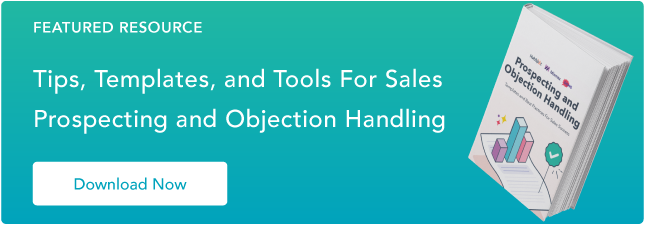Though many salespeople despise prospecting, it’s an important part of sales.
Unfortunately, the majority of reps use ineffective and outdated sales prospecting techniques, instead of the effective practices that could actually lead to a higher volume of well-qualified leads (and make them more partial to prospecting).
Just like every other aspect of the sales process, you need to put in the effort and focus required. This is the only way to prospect efficiently so that you don’t waste your time on unqualified leads that aren't suited for your product or service.
Use these modern sales prospecting techniques to help you better find leads who you can serve, engage, and eventually, convert to customers.
Sales Prospecting Methods
Sales prospecting methods are any way a salesperson conducts outreach to source new leads or engage with existing leads. Effective prospecting methods can vary by sales organization and industry and can include email outreach, social selling, event networking, and warm outreach over the phone.
Traditionally, there were two very different types of prospecting: outbound and inbound. Outbound was an approach that required the salesperson to conduct "cold" outreach in which they called and emailed prospects who had not opted in to speaking with them.
Inbound sales took the opposite approach, encouraging salespeople to build relationships with their prospects and call or email only those prospects who had expressed interest in their product or service.
Today, most sales experts agree the best approach to sales prospecting is a combination of both inbound and outbound selling.
Sales Prospecting Techniques
- Make warm calls.
- Become a thought-leader.
- Be a trusted resource.
- Reference a script.
- Don’t sell.
- Follow up.
- Use video.
- Block of time for prospecting.
- Spend time on social media.
- Host a webinar.
- Ask for referrals.
- Network at events.
- Answer questions on Q&A forums.
- Get involved in Twitter chats.
1. Make warm calls.
Your initial contact with new prospects doesn't have to be — and in fact, shouldn't be — completely cold. It can be incredibly useful to warm up your prospects before making the initial contact.
You can increase your chances of a warmer reception by familiarizing the prospect with your name or your company affiliation before you make your first call or send your first email.
A few ideas as to how to achieve this: get introduced by a shared connection, comment on a piece of content the buyer shared on social media, or "like" a status update or job change announcement on LinkedIn.
2. Become a thought-leader.
By establishing yourself as a thought leader or subject matter expert in your industry, you can establish your credibility and trust before reaching out to new prospects.
Ways to establish yourself as a thought leader include starting a blog, writing guest articles for industry publications, and speaking at trade shows and conferences.
This also helps you familiarize your leads with your name before the initial contact, which can improve sales email results.
3. Be a trusted resource.
To be successful as a salesperson, you have to do more than sell. You have to be your client's go-to person and support them after you’ve closed the sale.
By changing your position from salesperson of products and services to a provider of solutions, you can increase your chance of getting referrals from happy customers.
Draw on these referrals when it comes time for you to introduce yourself to a new prospect. When you become a resource for your clients, before and after the sale, they’ll remember your help and will be willing to help you in return.
4. Reference a script.
For new salespeople, referencing a basic script while prospecting can help them reduce uncomfortable pauses, use the right language, and respond to common objections.
Experienced, seasoned sales representatives often recommend not using a script in order to sound more natural during conversations.
However, some do still use a script — it’s just so ingrained in their minds that it comes out sounding natural and unrehearsed. But whether you use a script or not, make sure to actively listen to your prospects and customize your conversation based on their needs.
5. Don’t sell.
Prospecting is the first step in selling, but in and of itself, it is not selling. It’s about sourcing leads who can then be qualified and entered into the sales funnel. Only once these steps have taken place can the selling begin.
If you want to be successful in today's sales environment, you need to focus on building relationships while prospecting. Start selling too quickly and you’ll put undue pressure on the prospect.
Building a foundation of trust can help you and the prospect become more comfortable with each other, so once selling techniques come into the picture, they’ll be more effective.
6. Follow up.
Keep the prospect in the loop and follow up at each step of the deal. Whether you're confirming a time for your next meeting or sending over additional resources, an email or call helps you build a relationship with your point of contact.
And it gives you the opportunity to further establish yourself as a trusted resource for the prospect, rather than simply following up with "just checking in".
7. Use video.
Make your outreach even more enticing to prospects by including a video. Use it to introduce yourself, provide additional content, or to recap your connect, discovery, or qualification call.
Capture the prospects' attention by adding "video" in the subject line, and include a thumbnail image that links to the video.
8. Block of time for prospecting.
Set aside dedicated prospecting time on your calendar each day. Prospecting isn't easy — more than 40% of salespeople say it's the most challenging part of the sales process.
By blocking off time to prospect, you'll be better off in the long run because you're actively filling your pipeline, which often results in more conversations and better win rates.
9. Spend time on social media.
Implement a social selling strategy and meet prospects wherever they are. It's likely that a fair amount of people who've researched your product are active on social media (e.g., Twitter, LinkedIn, Facebook, etc.). Answer their questions and share content that's relevant to their research.
And your social selling activities can have a positive impact on your sales. In fact, companies who use social selling practices regularly are 40% more likely to hit their revenue goals than those who don't have a social selling process.
10. Host a webinar.
Webinars are a perfect place to source leads, because you know the attendees have a demonstrated interest in the topic. Partner with another organizations in your industry to host a webinar on a mutually beneficial topic.
After the webinar, poll your audience to see who's ready to learn more about your product/service. Consider a polling form that asks them to answer "Yes" or "No" to statements like "I'm ready for a demo," or "I'd like to learn more about [Your company name.]"
Follow up with those who responded positively to your poll or post-webinar survey within 24 hours, and schedule time for them to learn more. And don't give up on those who said they weren't yet ready to buy.
Place them into nurture campaigns, and stay in touch over the next few months to see if their buying position changes.
11. Ask for referrals.
If you're not asking for referrals, you're leaving your most reliable prospecting well untapped. Once you've successfully closed new business, ask your prospect or champion if there's anyone in their professional network you might connect with.
It's also a good idea to use follow-up communications over the next few months as another moment in which to ask for new connections.
For example, after your customer has onboarded (and is happy with their experience) ask, "I'm so glad you're already finding value in Sunrise Staffing Software Solutions. Is there anyone in your professional network who might also benefit from chatting with us?"
12. Network at events.
First, find the right events to attend. Identify why people are attending a certain conference, if the agenda has topics relevant to your ideal customer, what the size of the community is, and the overall purpose of the event.
If you sell project management software to entry- and mid-level designers, you might want to avoid a conference targeted toward design leaders or creative directors who aren't in the weeds with the types of software their designers are using.
Once you identify the events that will give you the greatest ROI, map out which sessions you'll attend, which happy hours or networking events you'll work, and whether or not your company will have a booth or speaking presence there.
13. Answer questions on Q&A forums.
Seek out ways to educate your audience on trends and best practices in your industry — and eventually educate them on your product.
Online forums, like LinkedIn Groups and Quora, allow likeminded people to post questions to the group members or audience and source answers from experts in the field. Join these platforms, and start by listening.
Get used to how people pose questions, review what is and is not allowed, and chime in on a few conversations before answering questions yourself. Once you've built some clout in the community, identify questions you can answer without bias.
For example, if you sell machinery for large agricultural operations, you might answer a question someone asks about the impact of AI on farming.
14. Get involved in Twitter chats.
Twitter chats are a great way to build rapport with prospects, and are an effective social selling tactic. In a recent article on gathering B2B sales leads, HubSpot's Managing Blog Editor Meg Prater says, "Twitter chats are when a group of people meet on Twitter to discuss a certain topic, trend, or interest area using an agreed-upon hashtag.
For example, if you sell a PPC tool, you might join the weekly #PPCChat, in which chat runners or guest hosts share a discussion topic ahead of time and industry folks share their thoughts and questions."
Questions are shared by the chat host and participants chime in with their answers using the chat hashtag.
Prater says, "Show up to these chats regularly and know when to contribute and when to listen. You’ll make connections with people each week, and you can ask if it’s alright to follow up with a few of them offline, after you’ve built foundational rapport."
Don't just stick to the same old sales prospecting playbook because it's what you've always done. Practice different techniques until you find the right mix of modern and effective sales techniques that effectively support your prospecting efforts and your sales goals.
To learn more, check out these ways to connect with prospects easily next.
Editor's note: This post was originally published in November, 2015 and has been updated for comprehensiveness.













